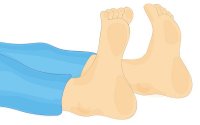Exercises to Prevent Post-Operative Complications:
Deep Breathing and Coughing
- This exercise can be performed in bed or in any other position (e.g. lying in bed or sitting in chair).
- Take 5 deep breaths followed by 2-3 coughs every 15 minutes.
- This should be performed every hour of the day that you are awake.
1. Ankle Pumping
- Lying on your back or sitting up in bed, move your ankles up and down as far as possible while keeping your legs straight.
- You may also move your ankles in circles.
- This should be performed every hour that you are awake, pumping each ankle 20 times.
- *If you keep your knee straight during this exercise you will feel a stretch in your calf muscles.


Discharge letter – discharge date will be determined by the attending physician on the day of discharge. Each patient will be given a discharge letter with details on the course of hospitalization and guidelines for further treatment and follow up.
Medical review and removal of staples – as a rule, staples are removed two weeks after the date of surgery.
Follow-up Schedule
After hip or knee replacement surgery, you can expect to have appointments:
- 6 weeks after surgery
- 3 months after surgery
- 1 year after surgery
- After the first year, should continue medical audit once a year.
Symptoms Requiring Immediate Attention
The surgery involves the rehabilitation and recovery period of approximately three months.
After being discharged from the hospital it is important that you abide strictly by your doctor’s instructions for further treatment and follow up.
Visit your nearest Emergency Department if you have any of the following:
- New or increased shortness of breath or difficulty in breathing
- New or increased pain, tightness or pressure in your chest
- A significant increase in pain, swelling or redness of your calf/calves
- A sudden, severe increase in pain in your new joint
Notify your surgeon/family doctor immediately if you experience any of the following symptoms:
- Increased redness, swelling or a sudden increase in bruising around the incision site
- Drainage from the surgical site for more than 4 days after discharge from the hospital
- A foul odor or yellow or green drainage at the incision site
- Excessive bleeding
- Signs or symptoms of other infections (e.g. bladder infection, tooth infection, etc.)
- A persistent increase in your temperature (over 38°C)
Prevention of Infections
It is important to let your dentist and other health care providers know that you have had joint replacement surgery as some procedures may expose you to the risk of infection.
For 2 years from the date of surgery (recommended for life), antibiotics should be taken prior to the following procedures:
- Before any dental work, including dental hygiene
- Urinary Tract Infection
- Skin infection
- Tooth infection
- All surgical treatment
DENTAL AND OTHER MEDICAL PROCEDURES
Contact your dentist or doctor a few days before any procedure to establish if any antibiotics should be prescribed and if so, to arrange that you are given a prescription.
Suggested prescriptions for dental procedures:
- Amoxicillin or Augmentin 2g orally 1 hour before procedure
For penicillin-allergic patients:
- Clindamycin 600 mg orally 1 hour before procedure
Please speak to your surgeon about appropriate time frames for these recommendations.
Please speak to your surgeon about appropriate time frames for these recommendations.
Daily Activity after Surgery
Returning to Work – this depends mainly on what type of duties you must perform and on the pace of recovery. Most patients do not return to work until at least 6 to 8 weeks after their surgery. When returning to work, you should make time for physiotherapy and strengthening exercises during the day.
Driving – Driving may be resumed after 6 weeks unless advised otherwise by your surgeon. Check with your insurance company about any concerns you may have regarding coverage when you resume driving.
Recommended Activities
- Walking – begin walking a short distance and when you feelcomfortable, increase the distance. Important principles include:
Step length – should be equal on both feet
Equal duration of the leg on the ground
Start the step from the heel to toes
- Swimming
- Cycling– begin on an exercise bike before riding outdoors
Activities to Discuss With Your Surgeon
- Skiing
- Mountain Biking
- Yoga (after hip replacement surgery)
High Risk Activities That Are NEVER Permitted
- Jogging / running
- Squash / racquetball
- Basketball
- Any contact sports
Sunnybrook’s Holland Orthopaedic & Arthritic Centre and Mount Sinai Hospital has developed part of this material and this has been edited by Dr. Michael Drexler. Permission to add this link to my website has been granted by Sunnybrook Health Sciences Centre’s and Mount Sinai Hospital Guides for Patients Having Hip or Knee Replacement.


